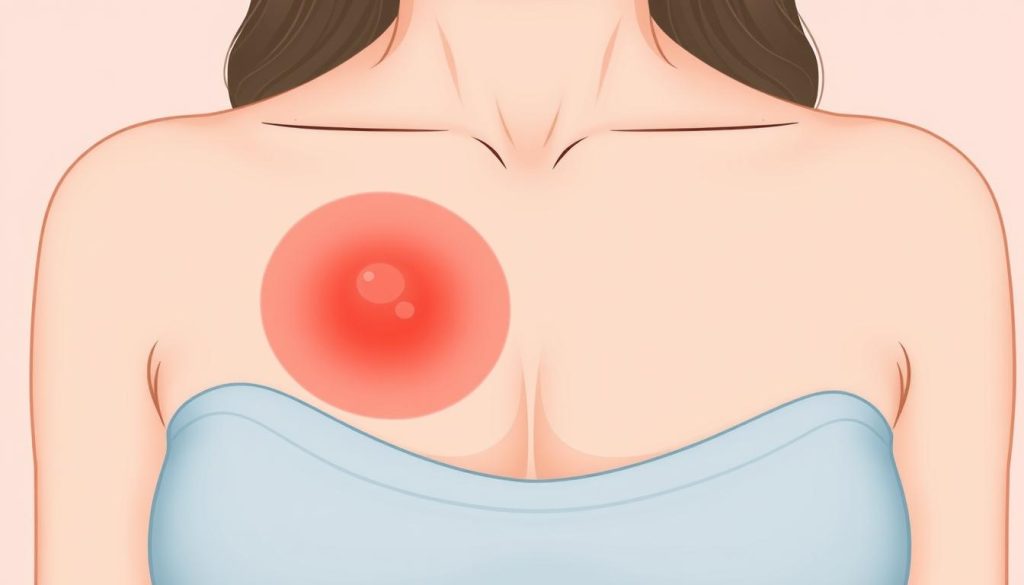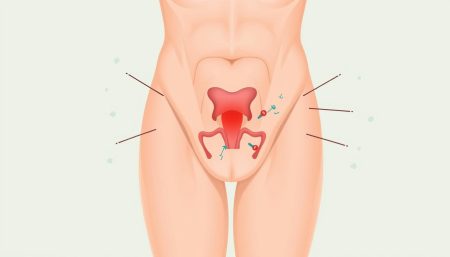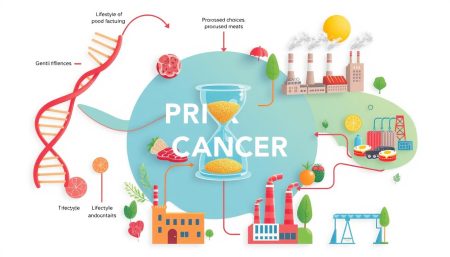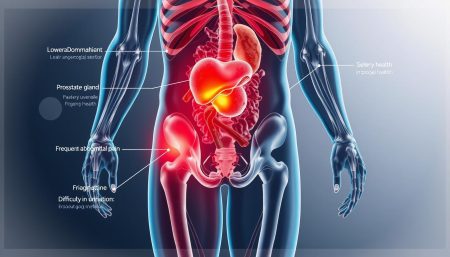Inflammatory breast cancer is a rare but aggressive form of breast cancer. It’s important to be aware of it because it often goes unnoticed by traditional screening methods. This makes early detection key.
This type of cancer can grow quickly, with symptoms appearing suddenly. It’s essential to recognize these signs early for timely treatment. We will look into what makes inflammatory breast cancer unique and why awareness is critical in fighting it.
Knowing the causes and warning signs of inflammatory breast cancer helps people take control of their health. By staying informed and alert, we can help improve treatment outcomes and support those dealing with this serious disease.
Understanding Inflammatory Breast Cancer: A Rare and Aggressive Form
Inflammatory breast cancer is a rare and aggressive type of breast cancer. It starts quickly and has unique symptoms. This cancer makes up only 1-5% of all breast cancers but needs urgent attention because it spreads fast.
Definition and Basic Characteristics
Inflammatory breast cancer happens when cancer cells block lymph vessels in the skin. This blockage makes the breast look swollen and red. It’s different from other breast cancers because it doesn’t form a lump. This makes it hard to find through self-exams or mammograms.
How It Differs from Other Breast Cancers
Inflammatory breast cancer spreads quickly. It can grow in just weeks or months. This fast growth makes it different from slower-growing cancers like metastatic breast cancer or triple negative breast cancer.
Statistical Prevalence and Risk Factors
Though rare, inflammatory breast cancer affects some groups more than others. Risk factors include:
- Age: More common in younger women
- Race: Higher incidence in African American women
- Obesity: Increased risk in overweight individuals
| Cancer Type | Prevalence | Average Age at Diagnosis |
|---|---|---|
| Inflammatory Breast Cancer | 1-5% of breast cancers | 52 years |
| Metastatic Breast Cancer | 6-10% of new breast cancer cases | 62 years |
| Triple Negative Breast Cancer | 10-20% of breast cancers | Mid 50s |
Early Warning Signs and Symptoms
Spotting breast cancer symptoms early can save lives. Inflammatory breast cancer is special because it doesn’t usually show up as a lump. This makes it harder to catch early.
Visual Changes in Breast Appearance
Inflammatory breast cancer can change how the breast looks. The skin might turn red, purple, or pink. It can also swell or feel warm.
Some women see dimpling or pitting, like an orange peel. This is a sign something is wrong.
Physical Symptoms to Watch For
There are physical signs too. The breast might grow quickly, feel heavy, or be tender. Nipples can flatten or invert.
Women might also feel itching or burning in the breast. These are warning signs.
Common Misdiagnosis Risks
Inflammatory breast cancer can look like other things, leading to wrong diagnoses. It’s often mistaken for infections or skin issues. This can cause delays in getting the right treatment.
If symptoms don’t go away after antibiotics, see a doctor again. It’s important to get checked out.
- Persistent redness or swelling
- Rapid breast changes
- Symptoms unresponsive to antibiotics
Knowing these signs helps people get help sooner. Catching it early is key to treating inflammatory breast cancer well.
Risk Factors and Genetic Predisposition
Knowing about breast cancer risk factors is key for early detection and prevention. Some risks can’t be changed, but knowing them helps you stay alert. Genetic predisposition is a big factor in breast cancer, including the aggressive inflammatory type.
Age is a major risk factor for breast cancer. Women over 50 are at higher risk, but younger women can get inflammatory breast cancer too. Family history also raises your risk. If your relatives have had breast cancer, your risk goes up.
Genetic mutations, like in BRCA1 and BRCA2 genes, increase the risk of inflammatory breast cancer. Other genes, like TP53 and PTEN, also play a role. Genetic tests can find these mutations and help prevent the disease.
| Risk Factor | Impact on Breast Cancer Risk |
|---|---|
| Age (over 50) | Significantly increases risk |
| Family History | Moderately increases risk |
| BRCA1/BRCA2 Mutations | Greatly increases risk |
| Dense Breast Tissue | Slightly increases risk |
Lifestyle choices can also affect your risk of inflammatory breast cancer. Being overweight, not exercising, and drinking too much alcohol can raise your risk. Staying healthy, exercising regularly, and drinking less can lower your risk.
The Biology of Inflammatory Breast Cancer
Inflammatory breast cancer is a rare and aggressive form of breast cancer. It has unique biological characteristics that set it apart from other types. Understanding these features helps explain its rapid progression and challenging treatment.
Cellular Changes and Growth Patterns
In inflammatory breast cancer, cells undergo rapid changes. They grow and divide quickly, forming clusters that block lymph vessels. This blockage causes the classic signs of inflammation in the breast.
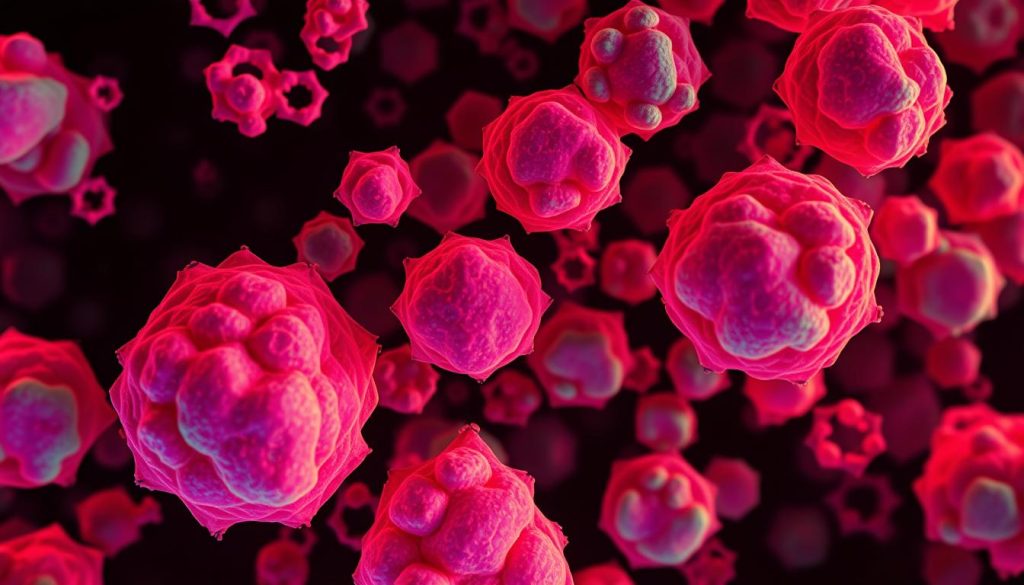
Lymphatic System Involvement
The lymphatic system plays a key role in this cancer’s spread. Cancer cells invade lymph vessels in the breast skin. This invasion leads to swelling and redness, key symptoms of inflammatory breast cancer.
Molecular Subtypes
Like other breast cancers, inflammatory breast cancer has different molecular subtypes. These subtypes affect treatment choices and outcomes. Triple negative breast cancer is one subtype that can occur in inflammatory cases.
| Subtype | Frequency | Treatment Response |
|---|---|---|
| Hormone Receptor Positive | 30-40% | May respond to hormone therapy |
| HER2 Positive | 35-40% | Targeted therapies available |
| Triple Negative | 20-30% | Limited targeted options |
The biology of inflammatory breast cancer explains its aggressive nature. Its unique growth patterns and lymphatic involvement contribute to rapid spread. Understanding these factors is key to developing effective treatments and improving patient outcomes.
Diagnostic Procedures and Testing Methods
Finding inflammatory breast cancer needs a mix of tests. Doctors use different methods to make a diagnosis and plan treatment. Finding it early is very important for better results.
Mammograms and ultrasounds are often the first steps. These tests can show breast cancer symptoms like thickened skin or swollen lymph nodes. MRI scans give detailed images of the breast tissue, helping doctors find problems.
Biopsies are key to confirming the diagnosis. Doctors take a small tissue sample for lab tests. This test checks if cancer cells are there and what type they are.
| Diagnostic Test | Purpose | Procedure |
|---|---|---|
| Mammogram | Detect breast abnormalities | X-ray of breast tissue |
| Ultrasound | Examine soft tissues | Sound waves create images |
| MRI | Detailed breast imaging | Magnetic fields and radio waves |
| Biopsy | Confirm cancer presence | Tissue sample analysis |
Blood tests look for markers that might show cancer spread. Genetic testing can find inherited mutations that increase breast cancer risk. These tests help doctors get a full picture for accurate diagnosis and treatment planning.
Staging and Assessment of Disease Progression
Knowing the stages of breast cancer is key for planning treatment. For inflammatory breast cancer, doctors use special methods to check how the disease is growing.
TNM Classification System
The TNM system helps doctors figure out how far cancer has spread. T shows the tumor size, N is for lymph nodes, and M is for metastasis. Inflammatory breast cancer usually gets a T4d rating because of its unique look.
| Category | Description | Impact on Staging |
|---|---|---|
| T (Tumor) | Extent of breast involvement | Always T4d for inflammatory breast cancer |
| N (Nodes) | Lymph node spread | N0 to N3 based on node involvement |
| M (Metastasis) | Distant spread | M0 (no spread) or M1 (metastatic) |
Metastatic Spread Patterns
Metastatic breast cancer can spread to many parts of the body. It often goes to bones, liver, lungs, and brain. Finding metastases early is important for planning treatment.
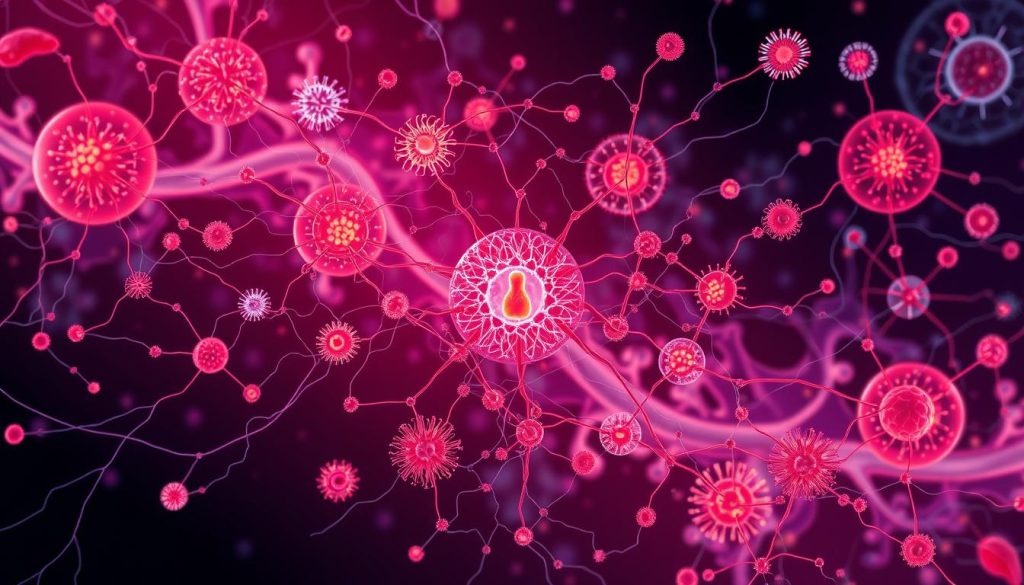
Imaging Technologies Used
Doctors use different imaging methods to check on inflammatory breast cancer growth:
- Mammograms for initial breast imaging
- Ultrasounds to examine breast tissue and lymph nodes
- MRI scans for detailed breast and chest wall views
- PET/CT scans to detect distant metastases
These tools help doctors get a full picture of the cancer. This guides treatment choices and checks how well treatments work.
Treatment Options and Modern Approaches
Inflammatory breast cancer treatment needs a mix of therapies. Doctors use chemotherapy, surgery, and radiation to fight this aggressive cancer. This combination is the standard approach.
Chemotherapy is often the first step. It shrinks tumors and stops cancer from spreading. After that, surgery removes any remaining cancer cells. Sometimes, this means removing the whole breast.
Then, radiation therapy targets any cancer cells left in the chest. Some patients might also get targeted therapies or hormone therapy. This depends on their cancer’s type.
- Neoadjuvant chemotherapy
- Mastectomy
- Radiation therapy
- Targeted therapies
- Hormone therapy
Today, treatments like immunotherapy and clinical trials are being explored. These new methods aim to better help patients with inflammatory breast cancer. Doctors make treatment plans that fit each patient’s needs, considering their cancer stage and health.
Chemotherapy Protocols and Management
Chemotherapy is key in treating breast cancer, including the aggressive inflammatory type. It needs a custom plan to get the best results.
Neoadjuvant Treatment
Neoadjuvant chemotherapy is often the first step for inflammatory breast cancer. It’s given before surgery to make tumors smaller. This improves surgery outcomes. Drugs like anthracyclines and taxanes are commonly used.
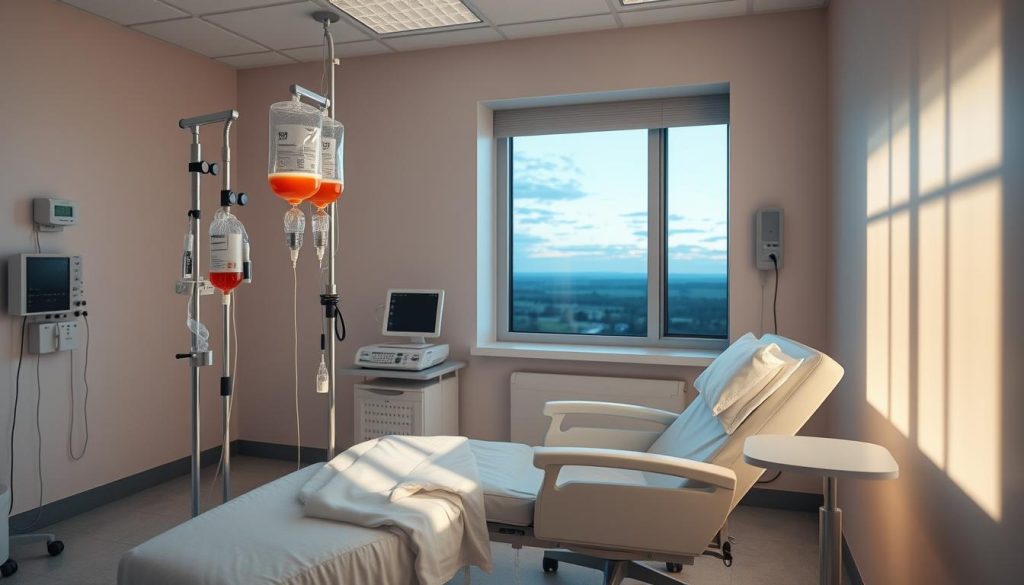
Adjuvant Therapy Options
After surgery, adjuvant therapy aims to kill any cancer cells left. For inflammatory breast cancer, this might include more chemotherapy, targeted therapies, or hormone therapy. It depends on the cancer’s type.
Managing Side Effects
Chemotherapy can lead to side effects like fatigue, nausea, and hair loss. Doctors work with patients to manage these. They aim to keep the patient’s quality of life high during treatment.
| Side Effect | Management Strategy |
|---|---|
| Nausea | Anti-nausea medications, small frequent meals |
| Fatigue | Rest, light exercise, balanced diet |
| Hair Loss | Scalp cooling, wigs, scarves |
| Lowered Immunity | Infection precautions, growth factor injections |
Knowing these treatment plans helps patients get ready for their journey. Talking openly with healthcare providers is vital. It helps manage inflammatory breast cancer well and keeps quality of life high during treatment.
Surgical Interventions and Recovery
Surgery is key in treating inflammatory breast cancer. The main surgery is a modified radical mastectomy. This removes the whole breast and some lymph nodes under the arm. Sometimes, doctors choose a skin-sparing mastectomy to keep more skin for later reconstruction.
Before surgery, patients often get neoadjuvant chemotherapy. This treatment makes the tumor smaller. It makes the surgery easier and increases the chance of removing the tumor successfully. After surgery, pathologists check the removed tissue to see if the treatments worked.
Recovering from surgery takes several weeks. Patients might feel pain, swelling, and have trouble moving their arms at first. Physical therapy starts soon to help regain strength and mobility. Sometimes, drainage tubes are used to prevent fluid buildup.
After surgery, taking care of the wound, managing pain, and slowly getting back to normal activities are important. Emotional support is also key, as adjusting to body changes can be tough. Many hospitals offer support groups and counseling for breast cancer survivors.
While surgery is a big part of treatment, it’s often followed by more therapies. These can include radiation, more chemotherapy, or targeted drugs to lower the chance of cancer coming back.
Radiation Therapy Guidelines
Radiation therapy is key in treating breast cancer, including inflammatory breast cancer. It precisely targets cancer cells. This aims to shrink tumors and stop them from spreading.
Treatment Planning
Doctors create a detailed plan for each patient before starting radiation. They use CT scans to map the affected area. They also mark the skin for accurate treatment.

Duration and Frequency
Radiation for inflammatory breast cancer usually lasts 5 to 7 weeks. Patients get treated 5 days a week. Each session is about 15 to 30 minutes long.
This schedule helps destroy cancer cells effectively. It also lets normal cells recover between treatments.
Expected Outcomes
Radiation therapy greatly improves outcomes for patients with inflammatory breast cancer. It lowers the risk of cancer coming back. It also boosts survival rates.
Side effects like skin irritation and fatigue are common. But, most go away after treatment ends. The long-term benefits make radiation a vital part of breast cancer care.
| Aspect | Details |
|---|---|
| Treatment Duration | 5-7 weeks |
| Frequency | 5 days/week |
| Session Length | 15-30 minutes |
| Primary Goal | Reduce recurrence risk |
Living with Inflammatory Breast Cancer
Life with inflammatory breast cancer is filled with challenges. Knowing the prognosis helps patients make better care choices. Many find support at breast cancer awareness events and support groups.
Adjustments are needed every day. Fatigue from treatments can limit what you can do. Physical changes can also affect how you see yourself.
You might need to change your work or home life. It’s important to talk openly with loved ones about your needs and feelings. This helps keep relationships strong and your emotional well-being in check.
Thinking about long-term health is key. Regular check-ups and scans become part of your routine. Some may deal with side effects from treatments that need ongoing medical care.
Living a healthy lifestyle is important. This includes eating well and exercising gently. It can help your overall health and possibly improve your treatment outcomes.
Emotional support is essential. Many find comfort in counseling or joining support groups for inflammatory breast cancer. These groups offer a place to share and learn from others. Getting involved in breast cancer awareness can also give you a sense of purpose.
- Seek professional help for emotional well-being
- Connect with support groups for shared experiences
- Maintain open communication with loved ones
- Adapt daily routines to accommodate new needs
- Stay informed about your health and treatment options
Living with inflammatory breast cancer is a journey of resilience. By focusing on self-care, building a strong support network, and staying informed, patients can face this challenge with hope and determination.
Support Systems and Resources
Facing inflammatory breast cancer can feel overwhelming. But, you’re not alone. There are many support systems and resources to help you through this tough time. Let’s look at the different ways you and your loved ones can get help.
Medical Support Teams
Your medical team is key to your care. They include oncologists, surgeons, nurses, and specialists. They work together to give you the best treatment.
These experts offer guidance and care plans made just for you. They help you fight inflammatory breast cancer with personalized care.
Support Groups and Communities
Connecting with others who get what you’re going through can be really comforting. There are breast cancer awareness groups and online communities for this. They’re safe places to share, ask questions, and find emotional support.
These networks offer valuable insights and ways to cope. They share experiences from those who have been through similar things.
Financial Resources
The cost of treating inflammatory breast cancer can be high. But, there are financial help programs available. These can cover medical costs, transportation, and even daily living expenses.
If you need help, talk to hospital social workers or cancer support organizations. They can tell you about financial aid options.
FAQ
Q: What is inflammatory breast cancer?
A: Inflammatory breast cancer (IBC) is a rare and aggressive form of breast cancer. It affects the skin and lymph vessels of the breast. Symptoms include rapid onset of redness, swelling, and dimpling of the breast skin, often without a distinct lump.
Q: How is inflammatory breast cancer different from other types of breast cancer?
A: IBC is different because it progresses quickly and has unique symptoms. These include breast swelling and skin changes. It also tends to block lymph vessels. This makes it often diagnosed at a more advanced stage, needing immediate, aggressive treatment.
Q: What are the early warning signs of inflammatory breast cancer?
A: Early signs include rapid breast swelling, redness or darkening of the breast skin, and dimpling. The skin may look like an orange peel (peau d’orange). Other signs are an inverted nipple and warmth in the affected breast. These symptoms appear suddenly and worsen quickly.
Q: Who is at risk for developing inflammatory breast cancer?
A: Anyone can get IBC, but it’s more common in younger women and African American women. Obesity and genetic factors may also increase the risk. Specific genetic links are being researched.
Q: How is inflammatory breast cancer diagnosed?
A: Diagnosis involves a physical exam, imaging tests (mammogram, ultrasound, MRI), and a biopsy. IBC’s unique presentation makes diagnosis challenging. It may need multiple tests for confirmation.
Q: What is the staging process for inflammatory breast cancer?
A: IBC is always staged as at least stage III at diagnosis. Staging uses the TNM system (Tumor, Node, Metastasis) and imaging tests. This determines the extent of the disease’s spread.
Q: What treatment options are available for inflammatory breast cancer?
A: Treatment includes neoadjuvant chemotherapy before surgery, followed by surgery (usually a mastectomy). Radiation therapy and additional systemic therapies may also be used. The treatment plan depends on the cancer’s specific characteristics.
Q: Can inflammatory breast cancer be cured?
A: While IBC is aggressive, treatment advances have improved outcomes. The prognosis depends on the stage at diagnosis and treatment response. Early detection and prompt treatment are key for the best outcomes.
Q: How does chemotherapy work for inflammatory breast cancer?
A: Chemotherapy for IBC starts before surgery to shrink the tumor. It continues after surgery to eliminate remaining cancer cells and reduce recurrence risk.
Q: What kind of support is available for patients with inflammatory breast cancer?
A: Support includes medical teams, oncology social workers, support groups, and online communities. Organizations like the Inflammatory Breast Cancer Research Foundation offer resources and connect patients with others facing similar challenges.
Q: Is inflammatory breast cancer always triple-negative?
A: No, IBC can be any molecular subtype. While a higher proportion of IBC cases are triple-negative, it can also be hormone receptor-positive or HER2-positive. This impacts treatment options and prognosis.
Q: How does radiation therapy help in treating inflammatory breast cancer?
A: Radiation therapy is used after surgery to target remaining cancer cells in the chest wall and lymph nodes. It’s essential for reducing local recurrence risk and is part of the treatment plan for IBC.












